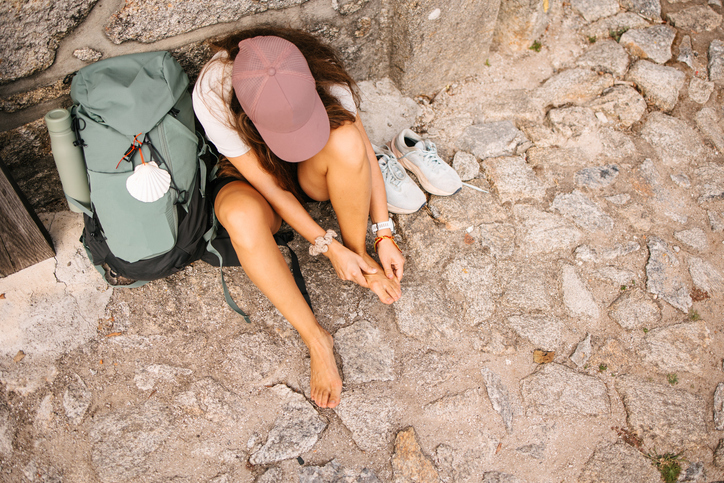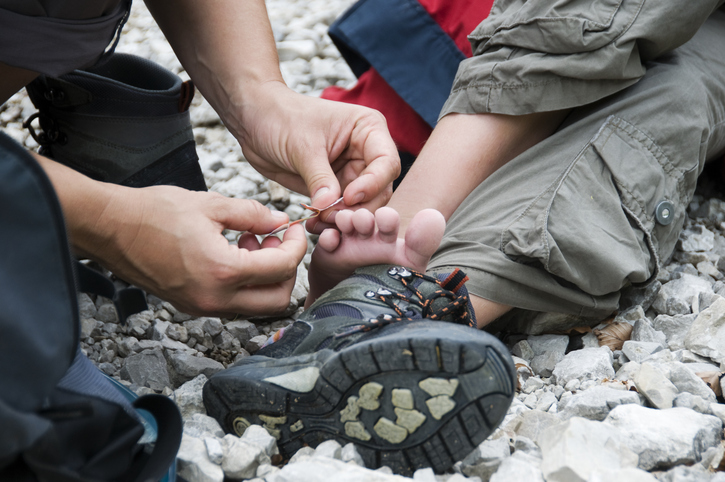No pain, no gain? Not when it comes to blisters. These small pockets of clear fluid under the skin may seem harmless, but they’re anything but — they can even be downright debilitating if they’re on a part of the body you need to navigate the day (like your feet!).
Unfortunately, they’re often a part of life if you’re active — at least until science finds a way to truly keep them from forming. It’s a pipe dream, though, since blisters have a real purpose.
What Are Foot Blisters?
“Blisters are nature’s way of protecting you,” says Johanna Youner, M.D., a New York City-based podiatrist. They form where there’s friction from too much rubbing, including your hands and feet. “Fluid collects in between layers of the skin and acts like a cushion,” she explains.
What Causes Foot Blisters?

Here are a few of the most common reasons why blisters form on your feet.
1. Shoes that don’t fit
One of the most common causes of friction blisters are ill-fitting shoes. When there’s too much room for your foot to move in loose shoes, it can lead to excessive rubbing on pressure areas, which can form blisters.
“I’ve seen some horrible, painful blisters from people who have bought shoes that were too large,” Dr. Youner says. “If the foot is intensely rubbing with repetitive motion, it will increase the chance of a blister.”
2. Moisture
Excessive moisture can also be a big factor, as it can weaken the skin and make it more susceptible to tears. That’s why you often feel the unmistakable sensation of a blister forming when you walk around with wet socks and shoes.
3. Allergies
In some cases, blisters or skin irritations can form as a result of an allergic reaction to certain chemicals or materials.
How to Prevent Blisters
Follow these tips to keep blisters from forming on your feet.
1. Invest in the right shoes
Finding well-fitting shoes can make a world of difference in preventing blisters. “Don’t look at the number,” says Dr. Youner. “Many people wear shoes that are too small.”
Your best bet is to get sized at a running specialty store that offers custom fitting. The experts measure your gait and other physiological aspects of your body and then recommend the best shoe for your unique situation.
Dr. Youner also recommends wearing breathable shoes (especially if you have sweaty feet) to mitigate moisture.
2. Get anti-blister socks
Socks are often an afterthought, but they’re also important. For example, WRIGHTSOCK’s Double Layer socks feature an inside and outside layer to eliminate excessive friction and moisture. But there are other similar moisture-wicking socks that can help prevent blisters.
Some runners even opt to wear knee-high pantyhose under a pair of socks to reduce the friction — the thought is that the friction that occurs between your skin and socks instead transfers to the two pairs of socks themselves, leaving your skin alone.
3. Fortify problem areas
David Newman, an ultramarathon runner (up to 100 miles at a time!), uses some serious protection for his well-worn feet. “For my long races, I lather my feet in Vaseline and then cover blisters, or places that often rub, with surgical tape,” he says. “That way there’s absolutely no chafing.”
You probably don’t need to go that far, but keeping the pain at bay can mean the difference between finishing your workout or sitting on the sidelines.
Foot Blister Treatment

Sometimes blisters just happen, no matter how many precautions you take. When that happens, it takes a lot of TLC to help them heal.
If you notice a “hot spot” or pain, put a bandage on it immediately to prevent further damage, advises Dr. Youner. “It will act as a second skin and the skin will react to try and repair itself.”
If you don’t have access to a bandage, put a layer between the affected area and whatever is hurting you. A napkin, paper towel, or gauze can help decrease the friction, she adds.
“If the blister is open, clean it with soap and water, apply Neosporin and a bandage,” she says, adding that liquid bandages are also a solid choice to cover the spots. “Adding powder helps, especially with 100 percent cornstarch. It will absorb moisture and will go a long way to keeping you safe.”
Should you pop blisters?
Backpacker Steve Silberberg routinely pops blisters when he’s hiking with one of his Fitpacking tour groups.
“I put Neosporin (or similar anti-bacterial) [on a blister] and cover with a bandage,” he says. “Then, in order to allow people to continue hiking, I cover the entire thing with duct tape.”
That’s an extreme way of dealing with them, but popping isn’t necessarily dangerous.
“It’s best to let nature take its course, but if it’s hurting when you walk or run, then pop the blister,” Dr. Youner says. “Wash your hands, clean the skin and a needle with alcohol. Then puncture the blister carefully and push gently to let the blister fluid out.”
Apply Neosporin and cover with a bandage, she advises. “If you have the ability, soak in Epsom salt bath and reapply Neosporin to avoid infection.” And don’t rip the blistered skin off — it hurts and can increase your chances of infection, too.

